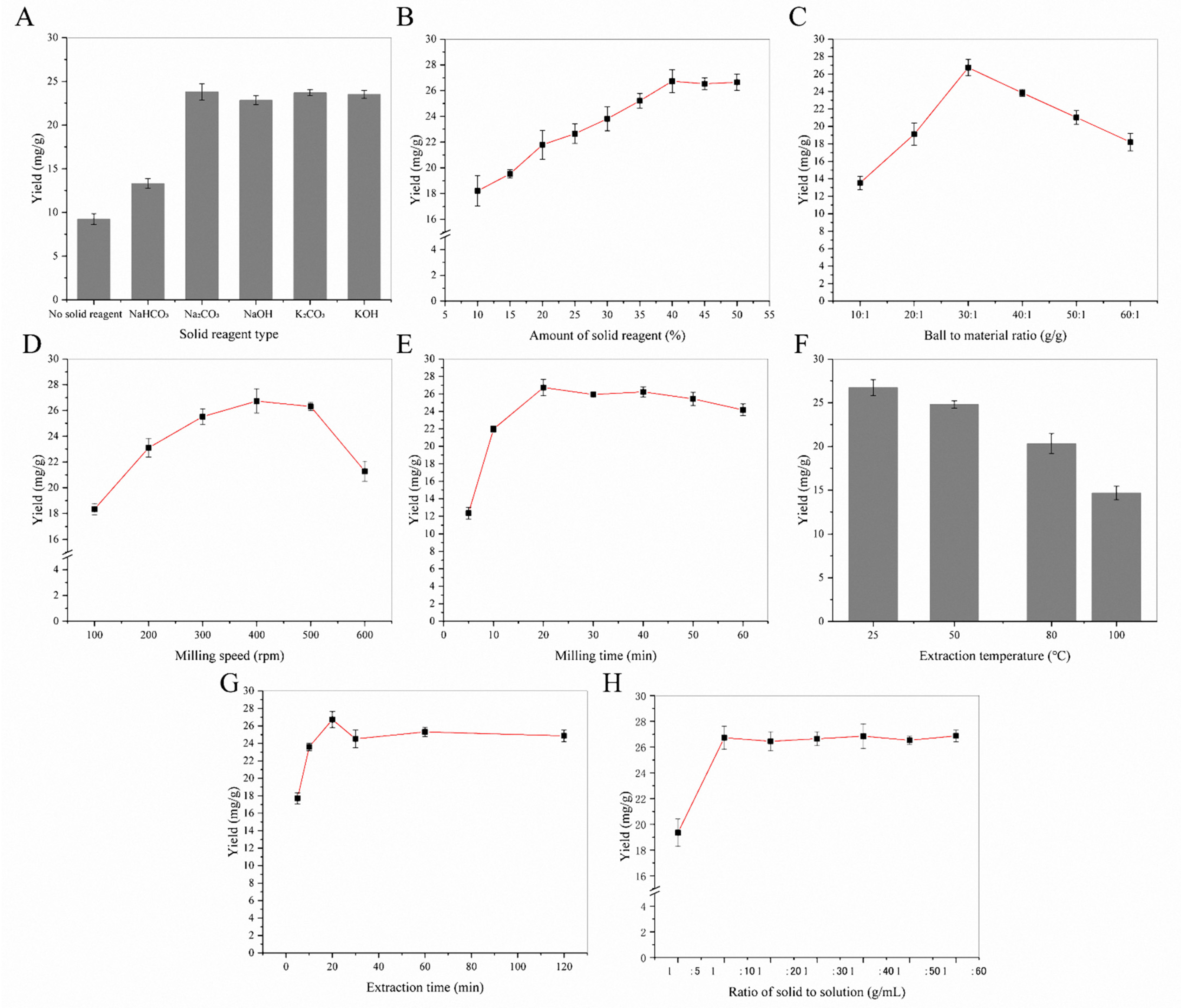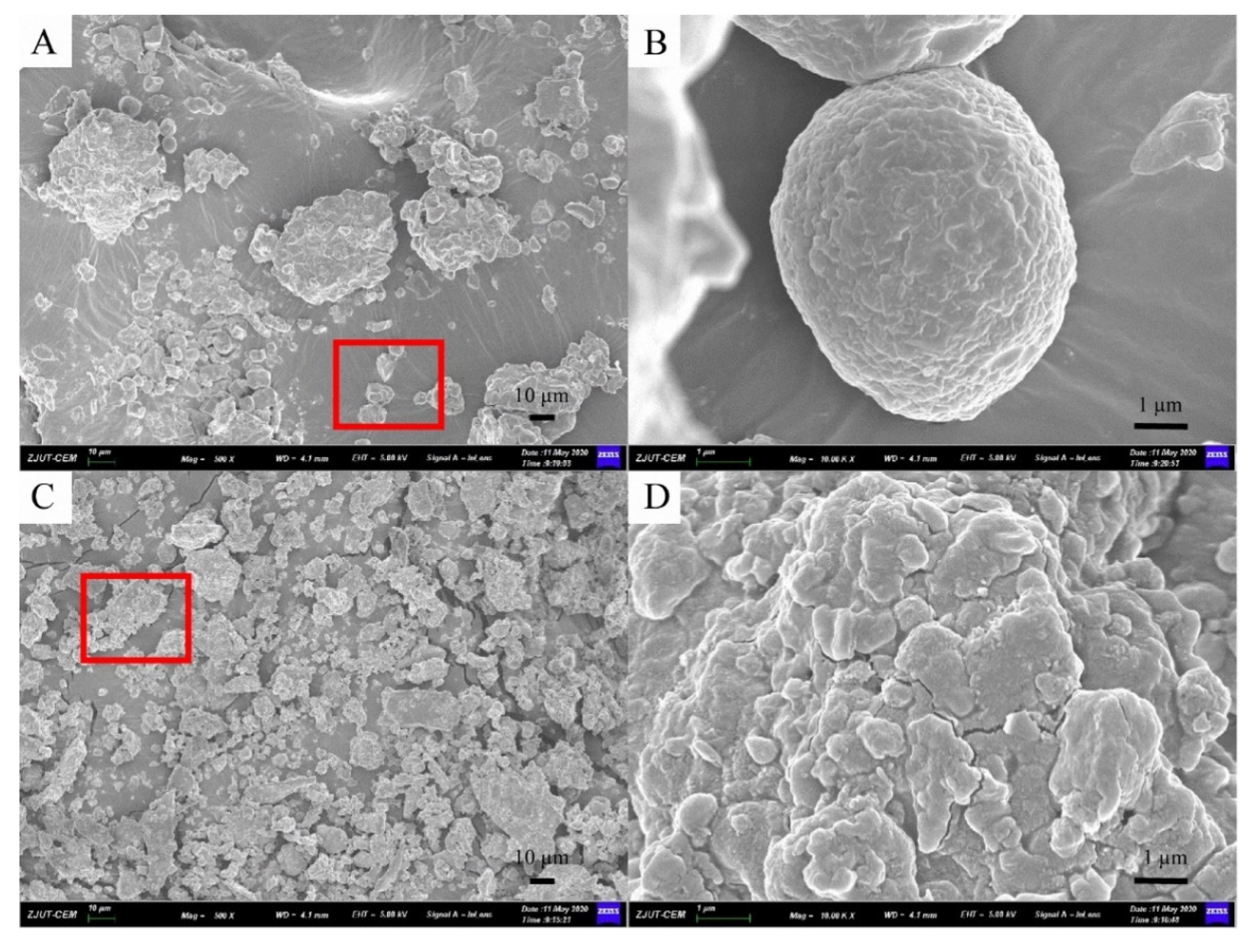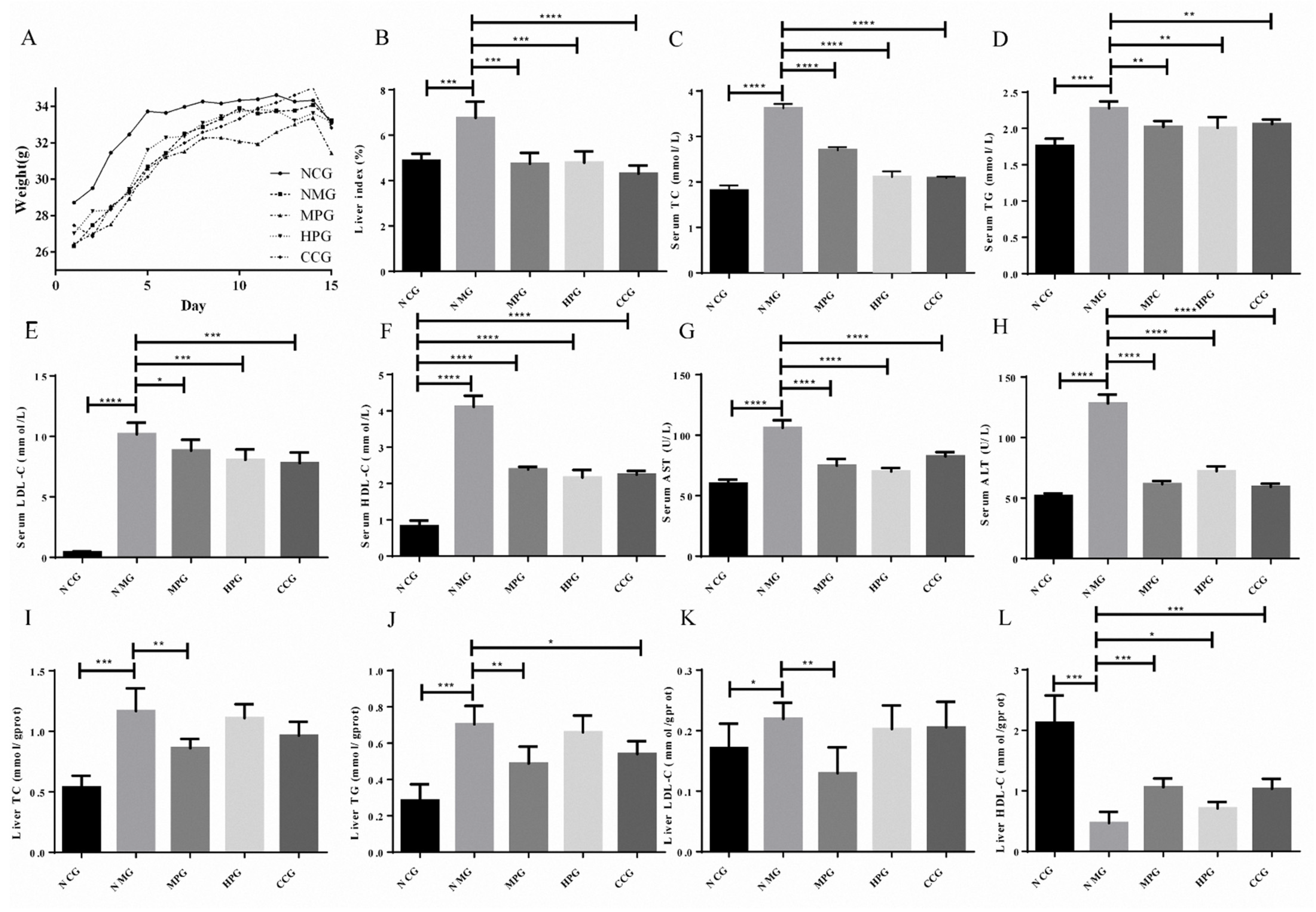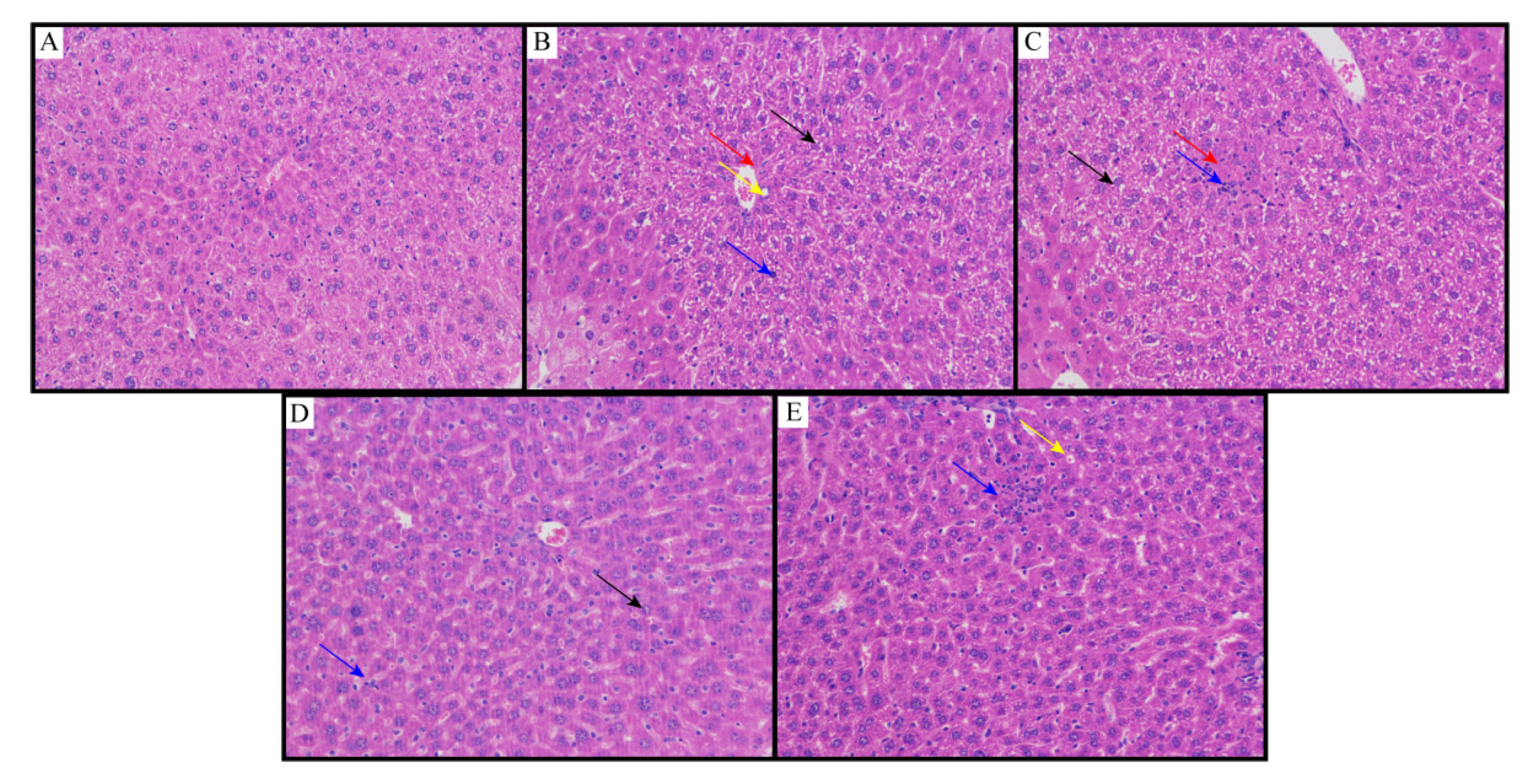Mechanochemical-Assisted Extraction and Hepatoprotective Activity Research of Flavonoids from Sea Buckthorn (Hippophaë rhamnoides L.) Pomaces
Abstract
:1. Introduction
2. Results and Discussion
2.1. Optimization of the MCAE Procedure
2.1.1. Effects of Solid Reagent Type and Its Amount
2.1.2. Effects of MCAE Paraments
2.1.3. Effects of Extraction Process
2.2. Quantitative and Morphology Analyses
2.3. Pharmacology Study
2.3.1. Body Weight
2.3.2. Liver Index
2.3.3. Serum Index
2.3.4. Liver Index
2.3.5. Histopathological Studies
3. Materials and Methods
3.1. Plant Materials and Chemicals
3.2. Pretreatment and Mechanochemical-Assisted Extraction (MCAE)
3.3. Total Flavonoids Determination
3.4. Purification of Total Flavonoids and HPLC Analysis
3.5. Scanning Electron Microscopy (SEM)
3.6. Animals
3.7. Biochemical Examination and Histopathological Studies
3.8. Statistical Analysis
4. Conclusions
Supplementary Materials
Author Contributions
Funding
Institutional Review Board Statement
Data Availability Statement
Acknowledgments
Conflicts of Interest
Sample Availability
Abbreviations
References
- Peng, H.L.; Gan, Z.D.; Xiong, H.; Luo, M.; Yu, N.X.; Wen, T.; Wang, R.H.; Li, Y.B. Self-assembly of protein nanoparticles from rice bran waste and their use as delivery system for Curcumin. ACS Sustain. Chem. Eng. 2017, 5, 6605–6614. [Google Scholar] [CrossRef]
- Sytařová, I.; Orsavová, J.; Snopek, L.; Mlček, J.; Byczyński, Ł.; Mišurcová, L. Impact of phenolic compounds and vitamins C and E on antioxidant activity of sea buckthorn (Hippophaë rhamnoides L.) berries and leaves of diverse ripening times. Food Chem. 2020, 310, 125784–125795. [Google Scholar] [CrossRef] [PubMed]
- Chen, C.; Xu, X.M.; Chen, Y.; Yu, M.Y.; Wen, F.Y.; Zhang, H. Identification, quantification and antioxidant activity of acylated flavonol glycosides from sea buckthorn (Hippophae rhamnoides ssp. sinensis). Food Chem. 2013, 141, 1573–1579. [Google Scholar] [CrossRef]
- Shi, L.; Zheng, L.; Zhao, C.; Jin, Q.; Wang, X. Chemical composition and antioxidant capacity of extracts fron the whole berry, pulp and seed of Hippophae rhamnoides ssp. yunnanensis. Nat. Prod. Res. 2019, 33, 3596–3600. [Google Scholar] [CrossRef]
- Wang, C.; Lei, M.; Zhang, H.; Zhao, L.; Mu, Z.; Wang, M.; Zhang, J.; Deng, Y.; Zhao, L. Comparison of metabolites in juice, seed and peel of sea buckthorn (Hippophae rhamnoides L. subsp. sinensis). J. Plant Biochem. Biot. 2020, 29, 305–313. [Google Scholar] [CrossRef]
- Redei, D.; Kusz, N.; Jedlinszki, N.; Blazso, G.; Zupko, I.; Hohmann, J. Bioactivity-guided investigation of the anti-inflammatory activity of Hippophae rhamnoides fruits. Planta Med. 2018, 84, 26–33. [Google Scholar] [CrossRef] [PubMed] [Green Version]
- Tkacz, K.; Wojdyło, A.; Turkiewicz, I.P.; Bobak, Ł.; Nowicka, P. Anti-oxidant and anti-enzymatic activities of sea buckthorn (Hippophaë rhamnoides L.) fruits modulated by chemical components. Antioxidants 2019, 8, 618. [Google Scholar] [CrossRef] [PubMed] [Green Version]
- Wei, E.; Yang, R.; Zhao, H.; Wang, P.; Zhao, S.; Zhai, W.; Zhang, Y.; Zhou, H. Microwave-assisted extraction releases the antioxidant polysaccharides from sea buckthorn (Hippophae rhamnoides L.) berries. Int. J. Biol. Macromol. 2019, 123, 280–290. [Google Scholar] [CrossRef]
- Galanakis, C.M. Recovery of high added-value components from food wastes: Conventional, emerging technologies and commercialized applications. Trends Food Sci. Tech. 2012, 26, 68–87. [Google Scholar] [CrossRef]
- Wu, C.H.; Murthy, H.N.; Hahn, E.J.; Lee, H.L.; Paek, K.Y. Efficient extraction of caffeic acid derivatives from adventitious roots of Echinacea purpurea. Food Sci. 2008, 26, 254–258. [Google Scholar] [CrossRef] [Green Version]
- Liu, D.F.; Guo, Q.; Yang, C.D. Method for Extracting Orientoside from Bamboo Leaves. CN Patent 101955479A, 26 January 2011. [Google Scholar]
- Liao, J.; Guo, Z.; Yu, G. Process intensification and kinetic studies of ultrasound-assisted extraction of flavonoids from peanut shells. Ultrason. Sonochem. 2021, 76, 105661–105671. [Google Scholar] [CrossRef] [PubMed]
- Wu, J.Y.; Lin, L.D.; Chau, F.-T. Ultrasound-assisted extraction of ginseng saponins from ginseng roots and cultured ginseng cells. Ultrason. Sonochem. 2001, 8, 347–352. [Google Scholar] [CrossRef]
- Drinić, Z.; Vladić, J.; Koren, A.; Zeremski, T.; Stojanov, N.; Kiprovski, B.; Vidović, S. Microwave-assisted extraction of cannabinoids and antioxidants from Cannabis sativa aerial parts and process modeling. J. Chem. Technol. Biotechnol. 2020, 95, 831–839. [Google Scholar] [CrossRef]
- Geng, Z.F.; Yang, Y.Z.; Yang, S.Y.; Zhou, J.Y.; Lyu, H.S. Purification of rutin by supercritical fluid simulated moving bed chromatography. Can. J. Chem. Eng. 2021, 2021, 1–12. [Google Scholar] [CrossRef]
- Isidore, E.; Karim, H.; Ioannou, I. Extraction of phenolic compounds and terpenes from Cannabis sativa L. by-products: From conventional to intensified processes. Antioxidants 2021, 10, 942. [Google Scholar] [CrossRef] [PubMed]
- Yang, X.H.; Chen, M. Extraction and purification of total flavones from leaves of Hippophae rhamnoides L. J. Shanxi Med Universicty 2007, 38, 1005–1009. [Google Scholar]
- Hui, R.J.; Feng, J.; Lin, M.H.; Feng, B.N. Optimization of extraction technology for flavonoids in leaves and seeds of Hippophae rhamnoides by multiindex-orthogonal test. China Pharm. 2017, 28, 4856–4859. [Google Scholar] [CrossRef]
- Li, F.; Liu, H.; Zhong, Y.; Liu, Y. Technology of total polyphenols and total flavones extracted from sea buckthorn leaves. Food Mach. 2012, 28, 128–130. [Google Scholar] [CrossRef]
- Jin, Z.; Liu, Q.; Kong, B.H.; Jia, N.; Li, J. Ultrasonic-assisted extraction of total flavonoids and antioxidant activities from sea buckthorn leaves. Food Ind. 2014, 35, 164–168. [Google Scholar]
- Fan, J.F.; Huang, Y.F.; Zhang, H.R. Extraction of flavonoids from fresh sea buckthorn leaves by microwave-assisted extraction. China Brew. 2009, 8, 94–96. [Google Scholar]
- Zhu, H.M.; Zhao, M.; Wang, W.H.; Wang, F. Study on enzymatic extraction of flavonoids from sea buckthorn leaves. Agric. Technol. 2008, 28, 30–32. [Google Scholar]
- Shi, D.D.; Li, M.; Su, N.; Sun, X.T.; He, R.X.; Wang, C.T. Process optimization and anti-oxidation evaluation of total flavonoids from Hippophae rhamnoides L. leaves by surfactant. Hubei Agric. Sci. 2017, 56, 1726–1729. [Google Scholar] [CrossRef]
- Xie, J.; Lin, Y.S.; Shi, X.J.; Zhu, X.Y.; Su, W.K.; Wang, P. Mechanochemical-assisted extraction of flavonoids from bamboo (Phyllostachys edulis) leaves. Ind. Crop. Prod. 2013, 43, 276–282. [Google Scholar] [CrossRef]
- Xie, J.; Shi, L.X.; Zhu, X.Y.; Wang, P.; Zhao, Y.; Su, W.K. Mechanochemical-assisted efficient extraction of rutin from Hibiscus mutabilis L. Innov. Food Sci. Emerg. 2011, 12, 146–152. [Google Scholar] [CrossRef]
- Zhu, X.Y.; Mang, Y.L.; Xie, J.; Wang, P.; Su, W.K. Response surface optimization of mechanochemical-assisted extraction of flavonoids and terpene trilactones from Ginkgo leaves. Ind. Crop. Prod. 2011, 34, 1041–1052. [Google Scholar] [CrossRef]
- Zhang, Q.H.; Yu, J.B.; Wang, Y.Y.; Su, W.K. Selective extraction of flavonoids from Sophora flavescens ait. by mechanochemistry. Molecules 2016, 21, 989. [Google Scholar] [CrossRef] [PubMed] [Green Version]
- Zhang, R.; Wang, Y.; Song, X.; Yang, J.; Dong, X.; Xie, T.; Wang, S.; Cao, J. Eco-friendly mechanobiological assisted extraction of phenolic acids and flavonoids from Chrysanthemum. J. Pharm. Biomed. Anal. 2020, 186, 113327–113338. [Google Scholar] [CrossRef] [PubMed]
- Liu, Q.; Pan, R.; Ding, L.; Zhang, F.; Hu, L.; Ding, B.; Zhu, L.; Xia, Y.; Dou, X. Rutin exhibits hepatoprotective effects in a mouse model of non-alcoholic fatty liver disease by reducing hepatic lipid levels and mitigating lipid-induced oxidative injuries. Int. Immunopharmacol. 2017, 49, 132–141. [Google Scholar] [CrossRef] [PubMed]
- Pan, P.H.; Lin, S.Y.; Wang, Y.Y.; Chen, W.Y.; Chuang, Y.H.; Wu, C.C.; Chen, C.J. Protective effects of rutin on liver injury induce by biliary obstruction in rats. Free Radic. Biol. Med. 2014, 73, 106–116. [Google Scholar] [CrossRef]
- Domitrovic, R.; Jakovac, H.; Vasiljev Marchesi, V.; Vladimir-Knezevic, S.; Cvijanovic, O.; Tadic, Z.; Romic, Z.; Rahelic, D. Differential hepatoprotective mechanisms of rutin and quercetin in CCl(4)-intoxicated BALB/Cn mice. Acta Pharmacol. Sin. 2012, 33, 1260–1270. [Google Scholar] [CrossRef] [PubMed] [Green Version]
- Miltonprabu, S.; Tomczyk, M.; Skalicka-Wozniak, K.; Rastrelli, L.; Daglia, M.; Nabavi, S.F.; Alavian, S.M.; Nabavi, S.M. Hepatoprotective effect of quercetin: From chemistry to medicine. Food Chem. Toxicol. 2017, 108, 365–374. [Google Scholar] [CrossRef]
- Sotiropoulou, M.; Katsaros, I.; Vailas, M.; Lidoriki, I.; Papatheodoridis, G.V.; Kostomitsopoulos, N.G.; Valsami, G.; Tsaroucha, A.; Schizas, D. Nonalcoholic fatty liver disease: The role of quercetin and its therapeutic implications. Saudi. J. Gastroenterol. 2021, 27, 319–330. [Google Scholar] [CrossRef]
- Ying, H.Z.; Liu, Y.H.; Yu, B.; Wang, Z.Y.; Zang, J.N.; Yu, C.H. Dietary quercetin ameliorates nonalcoholic steatohepatitis induced by a high-fat diet in gerbils. Food Chem. Toxicol. 2013, 52, 53–60. [Google Scholar] [CrossRef] [PubMed]
- Fuentes, J.; de Camargo, A.C.; Atala, E.; Gotteland, M.; Olea-Azar, C.; Speisky, H. Quercetin oxidation metabolite present in Onion peel protects Caco-2 cells against the oxidative stress, NF-kB activation, and loss of epithelial barrier function induced by NSAIDs. J. Agric. Food Chem. 2021, 69, 2157–2167. [Google Scholar] [CrossRef] [PubMed]
- Fuentes, J.; Brunser, O.; Atala, E.; Herranz, J.; de Camargo, A.C.; Zbinden-Foncea, H.; Speisky, H. Protection against indomethacin-induced loss of intestinal epithelial barrier function by a quercetin oxidation metabolite present in onion peel: In vitro and in vivo studies. J. Nutr. Biochem. 2021, 100, 108886–108895. [Google Scholar] [CrossRef] [PubMed]
- Oyarzun, J.E.; Andia, M.E.; Uribe, S.; Nunez Pizarro, P.; Nunez, G.; Montenegro, G.; Bridi, R. Honeybee pollen extracts reduce oxidative stress and steatosis in Hepatic cells. Molecules 2020, 26, 6. [Google Scholar] [CrossRef] [PubMed]
- Toita, R.; Kang, J.H. Long-term profile of serological biomarkers, hepatic inflammation, and fibrosis in a mouse model of non-alcoholic fatty liver disease. Toxicol. Lett. 2020, 332, 1–6. [Google Scholar] [CrossRef] [PubMed]
- Cui, A.; Hu, Z.; Han, Y.; Yang, Y.; Li, Y. Optimized analysis of in vivo and in vitro hepatic steatosis. J. Vis. Exp. 2017, 121, 55178. [Google Scholar] [CrossRef]






| Extraction Methods | Extraction Time | Extraction Temperature | Solvent | Amount of Solvent | Yield of Flavonoids (mg/g) a |
|---|---|---|---|---|---|
| MCAE | 24 min | 25 °C | Water | 1:10 g/mL | 26.82 ± 0.53 |
| HRE | 2 h | 50 °C | Ethanol | 1:40 g/mL | 8.99 ± 0.10 |
Publisher’s Note: MDPI stays neutral with regard to jurisdictional claims in published maps and institutional affiliations. |
© 2021 by the authors. Licensee MDPI, Basel, Switzerland. This article is an open access article distributed under the terms and conditions of the Creative Commons Attribution (CC BY) license (https://creativecommons.org/licenses/by/4.0/).
Share and Cite
Guo, Z.; Cheng, J.; Zheng, L.; Xu, W.; Xie, Y. Mechanochemical-Assisted Extraction and Hepatoprotective Activity Research of Flavonoids from Sea Buckthorn (Hippophaë rhamnoides L.) Pomaces. Molecules 2021, 26, 7615. https://doi.org/10.3390/molecules26247615
Guo Z, Cheng J, Zheng L, Xu W, Xie Y. Mechanochemical-Assisted Extraction and Hepatoprotective Activity Research of Flavonoids from Sea Buckthorn (Hippophaë rhamnoides L.) Pomaces. Molecules. 2021; 26(24):7615. https://doi.org/10.3390/molecules26247615
Chicago/Turabian StyleGuo, Zili, Jingya Cheng, Lei Zheng, Wenhao Xu, and Yuanyuan Xie. 2021. "Mechanochemical-Assisted Extraction and Hepatoprotective Activity Research of Flavonoids from Sea Buckthorn (Hippophaë rhamnoides L.) Pomaces" Molecules 26, no. 24: 7615. https://doi.org/10.3390/molecules26247615
APA StyleGuo, Z., Cheng, J., Zheng, L., Xu, W., & Xie, Y. (2021). Mechanochemical-Assisted Extraction and Hepatoprotective Activity Research of Flavonoids from Sea Buckthorn (Hippophaë rhamnoides L.) Pomaces. Molecules, 26(24), 7615. https://doi.org/10.3390/molecules26247615






